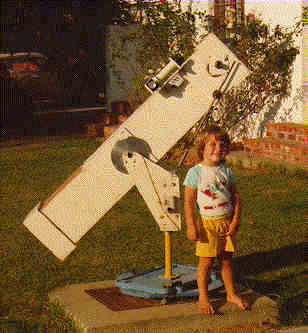|
The choice of mounts that
are stable and portable enough ended up being
between a Dobsonian and a Split-ring equatorial. Although a Dobsonian
can be
made more compact it is more complicated to drive. Dobsonian drive
options were
either an equatorial table or a dual axis computer controlled drive. An
equatorial table for 33° latitude has its problems and my
Olivetti was not
powerful enough for the computerized drive. In the end I opted for a
fold-able
Split-ring Equatorial.
To see picture-book
style expanded views
of how the above requirements were implemented - from using a motor-car brake drum
as a mirror cell to a unique
way of gripping the bottom ends
of the truss poles to allow instant release - let us split the
telescope into the following 3 subsections:
 Top-end Top-end
 Mirror Box
Or just click on the corresponding part
of the image Mirror Box
Or just click on the corresponding part
of the image
 Mount Mount
Here is an animation (160k)
if you want to see how this was accomplished in 5 easy steps. 
Since I was basically
designing as I was building, this was about the closest I ever got to
any kind of an "engineering
drawing".
If you need more
information on certian aspects of my telescope, go see if someone else
did not perhaps ask it already in my
Telescope FAQs Page
|



